Skin diseases are a significant obstacle to a person’s full life. In addition to causing discomfort and pain, various manifestations on the skin are reflected in appearance, resulting in mental disorders. With the help of complex therapy and a competent approach, specialists manage to combat these unpleasant phenomena. This article provides information on how neurodermatitis is treated in adults.
What is neurodermatitis?
Neurodermatitis is a dermatological disease that becomes chronic over time. Pathological manifestations can begin in early childhood and bother the patient throughout his life. Relapses of this disease make themselves felt at any age and at different intervals.
According to the ICD, neurodermatitis is part of the group of allergic dermatoses and is considered the most common skin disease. More than 30% of patients who sought help at the hospital were registered.
Externally, the affected areas appear in the form of papules. These are flat, oval-shaped formations, accompanied by severe redness, blistering and unbearable itching. The skin at the affected sites becomes dry and begins to peel.
Adults suffer more from focal neurodermatitis. In this case, skin inflammations are localized in different places of the body. Lesions can affect the bends of the elbows and knees, the back of the head and the adjacent area of the neck. In men, the rash may appear around the anus and scrotum.
Diffuse rashes of neurodermatitis (atopic dermatitis) are characterized by more extensive areas of localization. They can spread to the skin of the face, neck, chest and curves. In medical reference books you can see photos of neurodermatitis at the stage of its exacerbation.
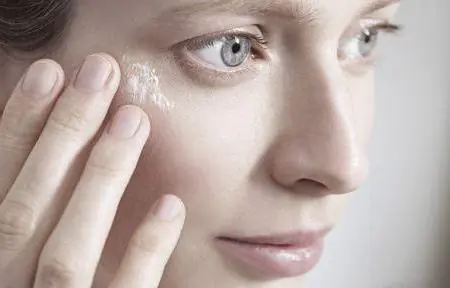
Forms of the disease
Depending on the location of the painful lesions, neurodermatitis is divided into the following types:
- Linear. The rash spreads to the scalp, legs, arms and flexure areas. It is difficult to treat because it becomes chronic over time. Treatment of neurodermatitis on the hands is complicated by the fact that the patient constantly has to expose the skin to contact with soap products. This increases pain, dries out the skin and promotes the formation of crusts.
- Limited. The name speaks for itself, since the lesions affect small areas of the skin. Places for their localization are such parts of the body as the groin, knees, thighs and genitals. A similar form of neurodermatitis on the legs is often found. The appearance of lesions is accompanied by severe irritation. After scratching such areas, the lesions take the form of papules and may become covered with scales. With this form of neurodermatitis, auxiliary measures to combat it are necessary - with the help of healing mud and electrophoresis. Ultrasound is used to treat lymph nodes.
- Diffuse. One of the most harmful skin diseases. In addition to the fact that it affects many parts of the body, it also affects the face. Rashes are observed on the eyelids and lips. They can also appear on the inner sides of the elbow and knee bends. Relief from such conditions is achieved through ultrasound sessions and physical therapy.
- Follicular. Characterized by rashes on areas of the skin with hair. The inflamed areas are reddish in color and often covered with a whitish coating. Its main location is the scalp under the hair. Against the background of such manifestations, many patients experience mental disorders.
- Psoriasiform. Affects the head and face area. Accompanied by constant itching. When such painful lesions occur on the head, partial baldness sometimes occurs. Dense red spots of this type of disease are characterized by scales similar to psoriasis.
- Hypertrophic. Affects the intimate parts of the body in both women and men. In the latter, the groin area is often affected. Treatment of hypertrophic neurodermatitis can be very problematic and is accompanied by nervous disorders in patients.

Causes
Doctors identify two main causes of this disease: endocrine disorders and a reaction to stress on the part of the nervous system. These factors are considered endogenous, since they provoke the onset of the disease from the inside.
The cause of rashes that appear under the influence of external factors (exogenous) is allergies. In this case, lesions on the skin are formed under the influence of antibodies from the outside. Manifestations caused by this factor may occur after skin contact with allergens to which the human immune system may be too sensitive.
According to some scientists, neurodermatitis is a hereditary disease, but this fact is not scientifically substantiated. However, many experts argue that a genetic factor is the main cause of this disease.
In addition, there are a number of factors contributing to the development of atopic dermatitis (neurodermatitis):
- nervous disorders;
- weakened immune system;
- disturbances in metabolic processes;
- chemical poisoning;
- malnutrition;
- prolonged stress;
- environmental pollution;
- excessive mental stress;
- heavy physical activity;
- predisposition to allergic diseases;
- bad habits.

Symptoms
External symptomatic manifestations include the following:
- roughening of the skin in the affected areas;
- irritation accompanied by itching;
- redness;
- excessive dryness;
- skin peeling;
- the appearance of small dropsies that develop into ulcers;
- formation of wet crusts;
- hyperpigmentation;
- cracks.
Symptoms of neurodermatitis in adults are not limited to external signs. Skin disease affects many functions of the human body. As a rule, such people are prone to apathy, feel depressed and suffer from chronic fatigue. Sometimes the patient may not be left with an obsessive feeling of anxiety, resulting in sleep disturbance.
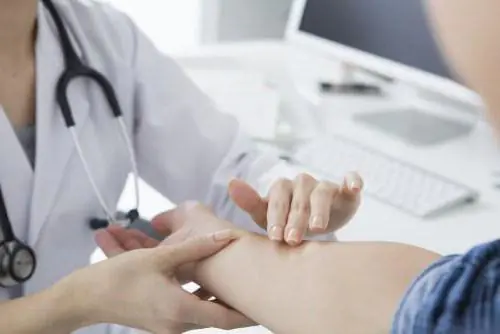
Treatment
During the discussion, it becomes clear that a disease such as neurodermatitis has several causes. Its symptoms are also quite varied and occur in different ways, which makes it difficult to combat. However, the good news is that with the help of a competent approach, medical workers are able to transfer the acute stage of the disease into a state of long-term remission, which significantly mitigates the pathological manifestations.
Experienced allergists and immunologists first try to identify the exact cause of the disease. This is the only way to choose the right treatment. The medication course is always aimed at eliminating the external source that serves as a provocateur of the disease. Therapy for skin diseases involves simultaneously combating cause and effect. This includes the use of ointments, mud baths, ultrasound sessions, taking specific medications, electrophoresis and traditional methods.
Treatment of neurodermatitis in adults should take place in a calm environment. It is good if it is inpatient, since the patient needs to be protected from unnecessary emotional worries. It is important to monitor your diet and practice good hygiene.
The treatment complex includes antihistamines that protect the body from allergens. They neutralize the effects of synthetic and various other substances that cause allergic reactions. Such drugs are: “Chlorpheniramine”, “Cetirizine”, “Loratadine”, “Promethazine”.
In most cases, treatment of neurodermatitis in adults is not complete without sedatives. A popular drug in this regard is Novo-Passit, as well as medications containing motherwort and valerian.
To normalize the functioning of the digestive organs, Linex, Festal, Pancreazim, and Hilak Forte are prescribed.
Immunomodulators are mandatory. The doctor selects medications for treatment depending on the degree of skin damage.
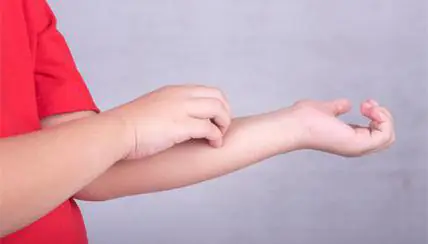
Local remedies are usually prescribed for a limited form of the disease. There is a wide selection of such drugs, but in each individual case they are selected individually. Among glucocorticoid drugs, the doctor may prescribe Betamethasone, Fluticasone or Clobetasol. There is an effective ointment for neurodermatitis with naphthalan oil. Tar products and various cream-gels give good results. Dermovate cream helps to cope well with local symptoms. It quickly eliminates pain and burning. It is important to remember that you cannot buy ointment without a dermatologist's prescription. Self-medication will most likely aggravate the development of the disease rather than help fight it.
Physiotherapeutic procedures
Treatment of neurodermatitis involves taking hydrogen sulfide and radon baths, as well as ultraviolet irradiation. It is good to alternate such methods with medicinal herbs. Baths with decoctions of chamomile, string and oak bark have an anti-inflammatory effect.
After completing the procedures, painful lesions are lubricated with fatty oils, for example, olive. Sulfur and ichthyol ointments are used.
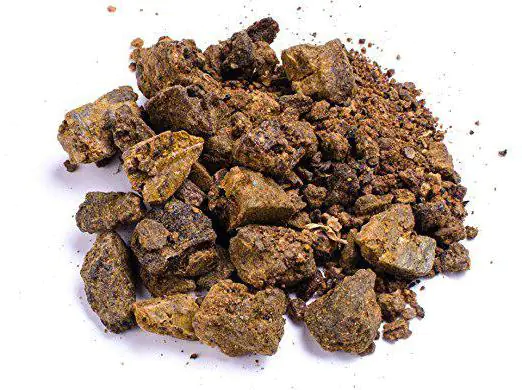
Treatment of neurodermatitis on the face
In addition to the common causes of atopic dermatitis, a rash on the face may appear due to the use of cosmetics or an allergy to animal hair. Even fur clothing or plant pollen can become an allergen.
As a rule, rashes in prominent places are accompanied by various complexes that can cause irreparable harm to mental health. Therefore, it is better not to delay the treatment of neurodermatitis on the face in adults.
- The medications prescribed are hormonal, antihistamine and sedatives.
- In most cases, experts consider it advisable to use sorbents. Activated carbon, Enterosgel and other similar agents are prescribed.
- Birch tar, zinc and dermatol agents are prescribed as ointments. To relieve irritation, you may need to use drugs - Flucinar and Elokom
- Physiotherapy is carried out using the following methods: ultrasound, selective phototherapy, ultraviolet light, electrosleep, hyperbaric oxygenation, laser therapy.
- Baths with the addition of salt and pine needles are used.
- Your doctor may prescribe additional products to prevent dry skin. During the period of remission, moisturizing creams must be used regularly. By the way, this also applies to skin care on the legs and arms. With atopic dermatitis, these parts of the body are more susceptible to external factors, and this leads to excessive dryness.
- Vitamin complexes must be included in the treatment. This is necessary to strengthen the immune system. The presence of vitamins such as A, B and E is especially important.
- Some benefits come from visiting spas and traveling to southern resorts.
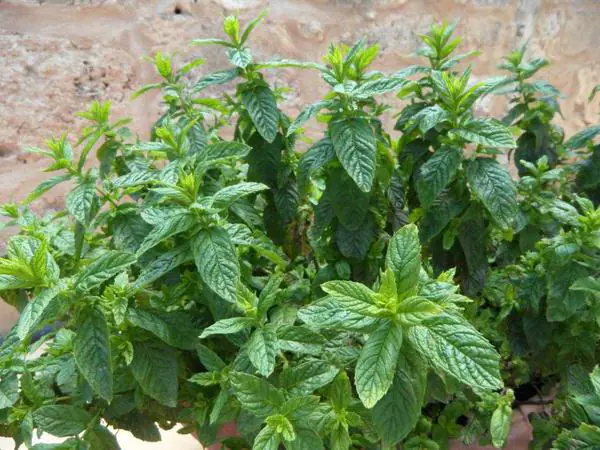
Nutrition and some recommendations
A diet for neurodermatitis involves avoiding all foods that cause allergies. These include: chocolate, bananas, nuts, citrus fruits, chicken eggs, honey. Smoked meats, coffee, strong tea and spicy foods are also excluded.
Red fruits and undiluted fresh juices can increase skin irritation. Preference is given to green apples, black currants, plums and other fruits.
It is recommended to consume milk soups and porridges, rabbit meat, turkey and beef. You can include some types of lean fish and fermented milk products in your diet.
Dried fruits and jelly can replace sweets and flour products.
It is better to cook, stew or bake in the oven. To prepare soups you need to use a second broth. Nutrition should be uniform - 3-5 meals per day.
During exacerbation of the disease, you should not drink alcohol.
Since personal hygiene for atopic dermatitis is of great importance, products such as creams, lotions, soaps and shampoos should be purchased in consultation with a specialist.
It is undesirable to wear clothes made of synthetic fabrics and pure wool. It is better to wash things with laundry soap.
It is necessary to wash your face and hands in warm water. After this, apply cosmetic milk or cream. This will help reduce dryness and flaking of the damaged areas. Well-moisturized skin feels less itchy and tight.
Traditional methods
At home, you can make an ointment for neurodermatitis based on Vaseline. It is combined with substances such as propolis or mumiyo in a ratio of 1:10. For this purpose, Vaseline is heated to a liquid state, mixed with one of the above components and cooled.
After using such folk remedies, neurodermatitis goes into remission much faster. Shilajit has an antimicrobial effect and eliminates pain. Propolis is an excellent analgesic and takes an active part in the regeneration of affected cells.
Ointments should be rubbed in with very light movements. You can also apply them to a sterile bandage and cover the affected areas with them.
It is good to use blue clay masks with added salt. It is applied to the lesions and kept until completely dry.
Herbal lotions are effective in treating neurodermatitis in adults. To relieve inflammation, infusions are prepared strong. Add 15 tablespoons of dry herbs to 1 liter of boiled water. They are poured with boiling water and left for about 10 hours. To prepare such a remedy, you need the following plants: chamomile, mint, marshmallow root, string, juniper, thyme, oregano, St. John's wort.
It should be remembered that traditional methods are not a panacea for the disease. Although their use does occur, they still play a supporting role in complex treatment.
Finally
Having received specific information about neurodermatitis (photos of symptoms in the article) and studied it carefully, you can draw certain conclusions. However, this does not mean that you need to make a diagnosis yourself. The final word should remain with the attending physician. A specialist must prescribe qualified treatment and monitor the progress of this process.
Neurodermatitis (or atopic dermatitis, or diffuse neurodermatitis) is a chronic inflammatory disease - allergic dermatitis, affecting the skin of people with a predisposition in the genome, as well as a disorder of the immune status, nervous and endocrine systems, and the functionality of other organs.
The presence of congenital heart abnormalities, clubfoot, hernias, cataracts, etc. in patients also indicates a hereditary factor of atopic dermatosis. Neurodermatitis has a persistent chronic, often recurrent nature, differing in form depending on age, causes, symptoms, as well as the season of the year.
The leading role in the occurrence of neurodermatitis belongs to the nervous system. Synonym for atopic dermatitis. Nowadays the term “atopic neurodermatitis” is also used. The mechanism of development of the disease is neuroendocrine. The consequence of diathesis is transition to childhood eczema - pruritus - neurodermatitis.
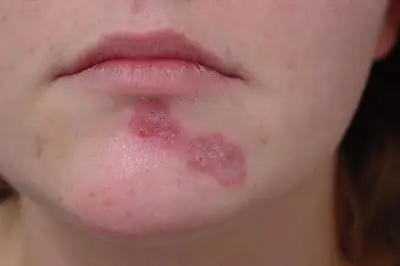
What it is?
Neurodermatitis is an inflammatory skin disease that occurs due to endogenous (occurring within the body) causes. It occurs mainly in childhood and adolescence, often becomes chronic and is one of the most common dermatological diseases on the planet.
Causes of the disease
Neurodermatitis is not a contagious disease. Often its root cause is a genetic predisposition to allergies. The human body can react with illness to any irritant - from the fur of a pet to your favorite cosmetic product.
Experts believe that common causes of neurodermatitis are:
- neuropsychiatric health disorders;
- medications;
- climatic factors;
- work in hazardous conditions and other irritating factors;
- poor nutrition, general toxic pollution of the body;
- prolonged psycho-emotional, mental and physical overload, depression;
- profound disturbances in the functioning of the immune, central and peripheral nervous systems, vegetative-vascular syndrome;
- sources of chronic infection, foci of inflammation in the body and bacterial accumulations on the skin;
- gastrointestinal diseases associated with disorders of fermentation processes, disruptions in the endocrine system, ENT diseases;
- genetic determination of the tendency to various allergic reactions, which is proven by the high intensity of diseases of close relatives and identical twins;
- endogenous factors - a polluted state of the surrounding external (street) and internal (indoor) environment, which can cause skin hyperreactivity.
Despite the variety of factors that provoke the development of neurodermatitis, dermatologists believe that the disease triggers an allergic mechanism. At the first meeting with an allergen, the body produces antibodies to a new compound, but the second time the antibodies combine with the body and are carried through the bloodstream to all tissues and organs and destroy the membranes of their cells.
During the process of degranulation, active substances are released, among which is histamine. This substance causes redness and thickening of the skin, an increase in local temperature and a feeling of itching or burning. In case of secondary infection, body temperature rises.
Scientists explain damage to the nervous system as the cause of neurodermatitis by dysfunction of peripheral nerve fibers. Therefore, the patient begins to experience severe itching, and rashes appear on the body. The desire to scratch the skin leads to injury, increased intensity of itching and swelling of the tissue.
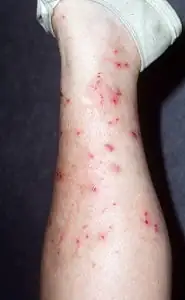
Classification
Neurodermatitis is a disease that has several types, which determine the extent of the pathological process in the patient’s skin.
- Diffuse neurodermatitis. This form is characterized by the appearance of multiple lesions. As a rule, they are localized on the upper and lower extremities (in the popliteal cavities and elbow bends), as well as on the torso. However, diffuse neurodermatitis often affects the neck, genitals, anus and face. In this case, the lesions are merging lichenified and infiltrated skin areas. In some places, in addition to lichenification, flat shiny nodules appear. Sometimes patients experience short-term weeping after scratching. As a result, the lesions can become infected, complicated by lymphadenitis or pyoderma. Patients suffering from diffuse neurodermatitis are characterized by swelling and hyperemia of the skin, often covered with small scales.
- Limited neurodermatitis. This type of neurodermatitis is characterized by the appearance on the surface of the skin of plaques covered with nodular neoplasms on the neck, in the knee and elbow bends, in the perineum, and on the genitals. With this type of disease, a symmetrical arrangement of plaques is often noted. As a rule, they appear simultaneously on both elbows, knees, and feet.
- Decalvating affects hairy areas of the body, causing gradual hair loss.
- Linear neurodermatitis. This is a pathology in which the lesions are localized mainly on the extensor surfaces of the arms and legs and have the shape of stripes, sometimes with a warty or flaky surface.
- Follicular: formed on the scalp of the body in the form of rashes that look like pointed papules.
- Psoriasiform neurodermatitis. In this case, the lesions are red lumps covered with small silvery-white scales. Most often they are localized on the head and neck.
- Hypertrophic: expressed in swelling in the area of the lymph nodes, most often the inguinal ones.
Each type of neurodermatitis brings significant discomfort to a person, so treatment is required without delay.
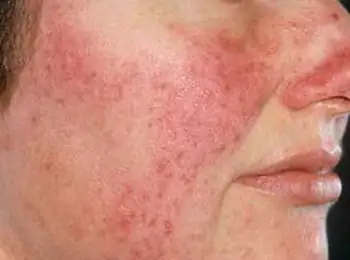
Symptoms of neurodermatitis
The main symptoms of neurodermatitis in adults and children are characterized by rash, itching, neurotic disorders, redness, and peeling. Moreover, the area of distribution of the disease can be varied depending on its specific variety.
With neurodermatitis, the function of the adrenal glands is significantly reduced, so the skin may darken noticeably. A person loses weight, which negatively affects the general condition of the body. Blood pressure decreases, fatigue, apathy and weakness increase, gastric juice secretion and blood glucose levels decrease. Neurodermatitis sometimes leads to lymphadenitis (inflammation of the lymph nodes), which impairs the functioning of many organs.
It should be noted that the symptoms of neurodermatitis are most pronounced in the winter and in the evening, and in the summer, on the contrary, noticeable improvements are felt. Neurodermatitis on the hands brings the greatest discomfort, since moisture and frequent mechanical stress only worsen the disease.
What does neurodermatitis look like, photo
The photo below shows how the disease manifests itself in adults and children.

How to diagnose correctly?
Diagnosis of neurodermatitis is carried out by a dermatologist at the first visit. To do this, the patient’s complaints and examination of his body are enough. To confirm the diagnosis, the patient may be prescribed laboratory and biochemical tests: his blood is checked for the number of leukocytes and eosinophils.
Most patients exhibit eosinophilia and leukocytosis, and immunological studies show an increased amount of IgE immunoglobulins. When secondary diseases occur, treatment of neurodermatitis and its symptoms can be adjusted in accordance with the overall clinical picture.
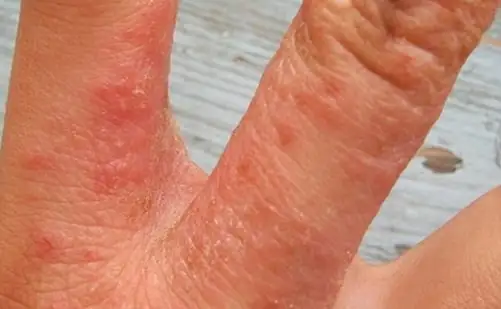
How to treat neurodermatitis?
Often neurodermatitis is treated in a very truncated manner and attention is paid only to skin manifestations. For relief of which local treatment is directed. However, it is worth considering the process as a whole and paying attention to all stages of treatment.
- Diet. Therapy begins, especially in the case of children, with dietary measures. It is ideal when it is possible to identify the main allergens that provoke the process and eliminate them from food. In adults, therapy also begins with the introduction of a diet with limited alcohol and spices. They try to breastfeed children or switch them to cow protein hydrolysates.
- General mode. Normalization of the general regime should include a full night's sleep (and for children, daytime sleep), sufficient time in the fresh air and rational mental and physical stress, excluding overwork and overexcitation of the nervous system. Treatment of neurodermatitis in adults with total lesions, localization on the palms, secondary purulent complications can be carried out on an outpatient basis with the issuance of a certificate of incapacity for work.
- Treatment of dysbiosis. During periods of exacerbation, it is also recommended to correct dysbiosis and start taking a course of enterosorbents (Enterosgel, Polyepana). It is not advisable to use sorbents on an ongoing basis, since they lead to the removal from the intestines of not only allergens, but also vitamins, which are quite difficult to replace due to dietary restrictions and intolerance to synthetic analogues.
- Sedatives. If necessary, patients are prescribed courses of sedatives or drug therapy for more severe neurological or mental problems.
General recommendations for neurodermatitis that can be performed at home:
1) The most important thing is to stop constantly scratching your skin. No treatment will be effective if the patient continues to scratch the lesions. For this:
- cut your nails short
- At night during an exacerbation, wear cotton gloves on your hands or sleep in cotton pajamas. This will reduce involuntary scratching during sleep.
2) It is very important to avoid contact with allergens that cause aggravation. For this:
- hypoallergenic diet required
- New clothes should be pre-washed.
- You should use soap-based laundry detergents
- clothes should be rinsed thoroughly
- Wet clean the house daily
3) Reduce dry skin. For this:
- Use creamy soaps and detergents with a moisturizing effect.
- water procedures should be short-term (5-10 minutes), in warm (not hot) water.
- After washing or swimming in the pool, apply body cream or milk to your body.
- Loose clothing made of pure cotton should be worn.
- It is advisable to abandon woolen clothes and woolen blankets, replacing them with clothes and blankets made of other materials.
Treatment tactics for neurodermatitis are aimed at eliminating the disorders that provoked the development of the pathological process, as well as at preventing relapses and prolonging remissions.
Drug treatment
The antiallergic niche of therapy involves the use of antihistamines, in most cases 2 and 3 generations of drugs, which have a less inhibitory effect on the central nervous system and at the same time stabilize mast cells and at the same time block the effect of histamine, but first generation drugs are still actively used. They have a relatively quick effect and cause drowsiness, which is actually not bad in the presence of itchy dermatosis.
- First generation: Fenistil in tablets or drops (Demitenden), Tavegil (Clemastin), in tablets or injections Pipolfen (Promethazine), Fenkarol (Hifenadine), Suprastin (Chlorpyramin).
- The second generation drug, Ketotifen (Zaditen), is preferable when a skin process is combined with bronchial obstruction.
- Third generation drugs: Astelong, Astemizole, Akrivastine, Acelastine, Allergodil, Gistalong, Histim, Claritin, Clarisens, Loratadine, Levocabastine, Semprex, Telfast, Terfenadil, Teridine, Cytherizine, Ebastine.
Glucocorticoids are used in severe cases of a common process during periods of exacerbation or the presence of allergic complications in the form of acute allergic reactions (urticaria, Quincke's edema).
- Natural: cortisone, hydrocortisone.
- Semi-synthetic corticosteroids: dexamethasone, triamcinolone, prednisolone.
Treatment with ointments with glucocorticoids is carried out once a day. Apply a thin layer, do not rub in. When taken as a course, they do not cause systemic side effects (Cushing's syndrome, adrenal insufficiency, skin atrophy and diabetes mellitus). When taken for years, the body's own release of adrenal hormones gradually decreases and systemic side effects develop.
- Weak strength drugs: non-fluorinated: hydrocortisone ointment, methylprednisolone aceponate.
- Moderate strength. Non-fluorinated: Laticort, Lokoid. Fluoridated: “Afloderm”, “Ftorokort”, “Triacort”, “Esperson”, “Lokakarten”, “Lorinden”.
- Strong. Fluorinated: “Dermovate”, “Cutivate”, “Beloderm”, “Celestoderm”, “Sinalar”, “Flucinar”, “Sinaflar”. Unphotorated: “Elokom”, “Advantan”.
The main task of non-hormonal drugs is to dry the skin (Zinc ointment or paste, Ski-derm) and have a softening effect (Gistan). However, some drugs also have an anti-inflammatory effect (Apilak, drugs based on tar and ichthyol), and also reduce itching (Elidel, Glutamol). They also use healing ointments (Bipanten, Panthenol).
Autosera are made from the patient’s own blood, which is collected at the peak of an exacerbation of neurodermatitis. Thus, the patient receives antibodies against allergens.
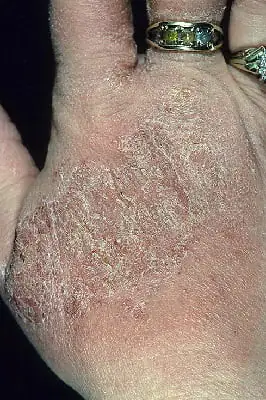
Physiotherapeutic treatment
A procedure such as phototherapy (using a quartz lamp, UV irradiation or selective phototherapy) has proven itself very well in the treatment of neurodermatitis. Selective phototherapy, which involves the use of UV rays with a wavelength of 315-320 nm, is indicated for patients suffering from neurodermatitis only during the period of remission of the disease. The duration of the course of treatment is 15-20 procedures.
Also, as a physiotherapeutic treatment for neurodermatitis, dermatologists recommend cryomassage (use of liquid nitrogen) and irradiation of lesions with a medical laser.
At the same time, sanatorium-resort treatment (on the coast of the Black and Dead Seas) has a very beneficial effect on the patient’s body.
Folk remedies
Based on natural ingredients, you can prepare various home remedies to successfully combat skin ailments. This:
- Lotions, baths, rubdowns. For various treatments of inflamed areas of the skin and for lotions, herbal decoctions with an anti-inflammatory and soothing effect are ideal. Well proven: chamomile, string, oregano, nettle, pine needles, thyme, plantain, mint. You can make both one-component infusions and decoctions from a collection of herbs.
- Creams, ointments. Most often, to prepare an ointment, pork fat/lard is used as a fatty base; it must first be melted and purified sulfur added until a homogeneous mass is obtained. Before use, thoroughly clean the affected areas with baby soap.
- Another homemade ointment recipe that can be prepared from any bird fat, beeswax, and birch tar. Mix all components, place in a ceramic container and leave for 4 hours in a warm place or on a heated surface.
- Compresses. Blue clay, which can easily be purchased at a pharmacy or cosmetic store, has proven itself to be very positive in the treatment of illness. The clay should be mixed with sea salt in equal proportions, add water and apply this slurry in an even layer to the affected areas. Next, you need to wait until the mixture dries and carefully rinse with warm water.
Nutrition rules
A diet for neurodermatitis in adults involves avoiding salt, hot and spicy foods, and foods containing large amounts of carbohydrates. In the acute period, foods with a high index of allergic activity are excluded from the diet:
During the period of exacerbation, you should avoid eating fatty meats and fish, fast food, canned food, and products containing artificial colors and flavors.
The emphasis in nutrition is on following a dairy-vegetable diet. It is healthy to eat fresh vegetables and fruits, salads with vegetable oil, and dairy products. It is recommended to drink more fluid (up to 2 liters per day). The diet includes boiled dietary meat, cereals, vegetable purees, and low-fat broths. It is better to replace sugar with xylitol or sorbitol. The preferred drinks are green tea, rosehip decoction, compotes, and mineral water.

Prevention
Prevention of neurodermatitis looks the same as prevention of any disease. Proper balanced nutrition, moderate physical activity, hardening and increasing immunity, avoiding stress. Dermatologists advise people prone to dermatological diseases to wear clothes made from natural materials that do not irritate the skin, so as not to provoke the development of the disease.
Also, during periods of remissions and exacerbations, you should not expose your skin to any irritants, for example, by doing peelings, scrubs, or using creams labeled “slimming” that contain substances that irritate the skin - pepper, cinnamon, menthol. And finally, it is important to protect sensitive skin from high and low temperatures.
Forecast
Since neurodermatitis does not threaten dangerous complications, the prognosis is the most favorable for life, although complete recovery does not occur in all cases. When the cause of neurodermatitis lies in deep allergic-genetic structures, it is impossible to exclude relapses, because therapeutic measures may not cover all manifestations of the disease.
Diffuse neurodermatitis with severe exacerbations can lead to long-term loss of performance. Limited neurodermatitis does not tend to become diffuse, which is why its prognosis is much more favorable.
12/26/2017 treatment 6,686 Views
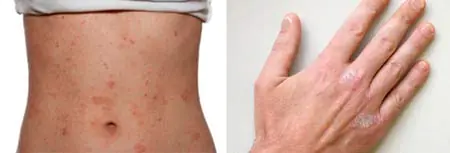
What kind of disease
It is noteworthy that neurodermatitis is excluded from the modern classification of diseases according to the ICD. This disease has been replaced by atopic dermatitis.
From the name of the pathology it is clear that its causes lie simultaneously in problems in two areas: the nervous system and the skin. This diagnosis is found in both men and women. Statistics show that the disease occurs more often in children and adolescents than in adults.
Among all dermatological problems, neurodermatitis accounts for about 40% of cases. Pathology develops under the influence of a group of endogenous factors, in particular, disorders in metabolism, internal organs and the nervous system.
Neurodermatitis is expressed in the formation of weeping rashes throughout the body, localized in different places. At subsequent stages of the pathology, crusts and thickening of the skin are formed in different places.
Important! If adults notice similar formations in a child, it is important to consult a doctor, since if the disease is not treated, the texture of the skin may change and other consequences may occur.
Reasons for the development of the disease
To successfully treat neurodermatitis, it is necessary to understand the causes of the disease and the influence of which factors should be excluded in order to reduce the likelihood of exacerbations and progression of the disease.
The main causes of neurodermatitis include:
- genetic predisposition;
- long-term emotional problems, depression, stress;
- external exposure to high dust levels or harmful substances from the environment;
- unstable life schedule with disturbances in sleep and rest patterns;
- constant physical stress;
- long-term drug abuse;
- food intoxication;
- frequent contact with allergens (pollen, wool, dust, fluff);
- lack of sleep;
- mental stress;
- disruptions in the functioning of the gastrointestinal tract;
- infectious diseases;
- decreased immunity.
It is believed that the risk of suffering from neurodermatitis is higher if a person very often and in large quantities uses hygiene products with synthetic composition, and also drinks chlorinated water.
Note! If you have allergies, the more variety of foods in your diet, the higher the likelihood of neurodermatitis.
Both during treatment at home and for prevention purposes, it is important to completely eliminate the negative impact of all these factors from your life.
Classification
There are several types of neurodermatitis and each type of pathology has its own characteristics. Let's take a closer look at each of these forms of the disease.
Limited form
Limited neurodermatitis is a form of the disease in which there are complaints of a rash only in a clearly limited part of the skin.
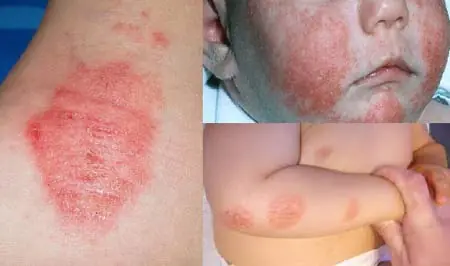
With this type of pathology, the lesions are concentrated in the following areas:
- on the neck;
- in the groin area;
- in the genital area;
- in the anal part;
- in the cubital fossa;
- under the knees.
The nature of the rash in this form of pathology is as follows:
- lesions have a clear round shape;
- often symmetrical;
- pink or brown;
- the skin in these places is dry;
- the edges of the affected area are clearly colored.
With focal neurodermatitis, the skin lesions do not become wet. The skin turns red and becomes covered with crusts and scales. Severe itching is felt, intensifying at night.
Diffuse form
With diffuse neurodermatitis, skin dermatitis is more severe. Multiple lesions form on the human body. Neurodermatitis occurs on the arms, legs, under the knees, and in the elbows. Neurodermatitis on the face, including on the cheeks, lips and nose, may become wet for a short time due to scratching, but without external influence the wounds quickly dry out.
Important! If the disease develops in childhood, the scalp and areas around the eyes are affected.
Hypertrophic form
Hypertrophic neurodermatitis is the rarest form of pathology, in which lesions form on the inner side of the thigh and in the groin.
Patients note severe itching, infiltration and lichenification of the skin. The disease can be complicated by warty formations.
Other forms of the disease
The following neurodermatitis is much less common:
- linear (localized in the folds, between the fingers, looks like stripes);
- follicular (papules form along the mouths of the hair follicles);
- depigmented (skin loses pigment and turns white);
- decalvating (affects the skin where there is vellus hair and leads to its loss);
- psoriasiform (red lumps with silvery scales, mainly on the head and neck).
Whatever form of pathology occurs, it must be diagnosed as soon as possible.
Symptoms
In order to make a timely diagnosis, you must be able to recognize the first signs of the disease. So, neurodermatitis can be identified by the following symptoms:
- severe itching, worsening at night;
- sensations cannot be controlled and the patient scratches the skin until weeping wounds form, which causes pain;
- after healing, the skin becomes rough;
- the tissues gradually become covered with rashes, pimples and spots.
The source of inflammation varies by zone. In the center, skin pigmentation is more pronounced and denser. The drawing is more clearly expressed. When papules form, they take on an unhealthy shine. These parts of the skin tend to be dry and flaky.
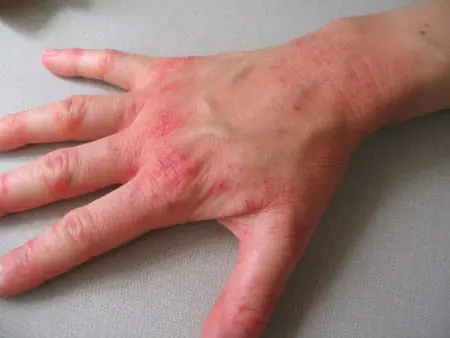
In addition to skin lesions, general symptoms may develop. Among them:
- general weakness;
- increased fatigue;
- decreased blood pressure;
- weight loss;
- decrease in blood sugar levels.
Some patients note malfunctions in the functioning of internal organs. Most often, with neurodermatitis, first aid may be required for the lymph nodes and adrenal glands.
Note! Constant itching can cause mental disorders.
In the presence of neurodermatitis, concomitant diseases often appear, especially bronchial asthma and contact dermatitis.
The course of neurodermatitis is seasonal. The most striking manifestations of this chronic pathology are in the autumn-winter period.
Diagnostics
A dermatologist diagnoses neurodermatitis. As a rule, making a diagnosis is not difficult. It is important for the doctor to differentiate this pathology from scabies, lichen planus, chronic forms of eczema, and some fungal skin lesions.
The doctor listens to what complaints the patient has, asks him about the chronic diseases of his relatives, and issues a referral for a blood test for immunoglobulins. If the skin is covered with pustules, it is necessary to carry out a bacteriological culture of the smear.
Treatment of the disease
To get rid of the symptoms of neurodermatosis, you must strictly follow the doctor's prescription.
Important! If you experience signs of illness during pregnancy, you should consult your doctor as soon as possible in order to select medications approved for use during this period.
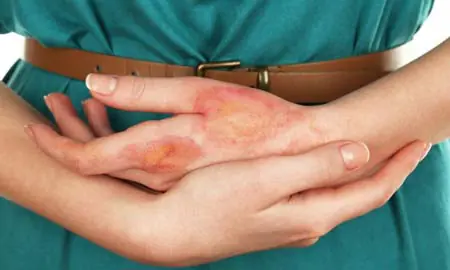
Therapy is aimed at eliminating the factors that provoke the disease. Thanks to treatment with competent methods, you can quickly cope with the symptoms and return to your normal lifestyle.
General treatment
In addition to the use of medications, the patient should consider the following recommendations:
- follow a strict diet;
- exclude contact with animals;
- do not come into contact with animal food, in particular fish food;
- Carry out regular thorough cleaning with moisture;
- remove carpets and clean anything that could be a habitat for dust mites;
- wear loose clothing so that it does not rub or injure the skin;
- avoid wearing items made from wool or synthetics;
- do not take baths and showers very often;
- try to avoid stress and overwork.
These recommendations will help you recover faster.
Drug therapy
For neurodermatitis, any medications should only be prescribed by a doctor. Self-medication can be dangerous.
As a rule, tablets that have a sedative effect are prescribed. This is necessary to normalize the functioning of the nervous system and improve overall well-being. Treatment with folk remedies is welcome. Tincture of valerian or peony shows a positive effect on neurodermatitis.
During the treatment process, ointments that soothe the skin, as well as local antiseptics can be used to prevent the addition of bacterial microflora. Antibiotics are prescribed only in this case. Such drugs do not help against neurodermatitis, but can have a negative effect on other organs and systems.
Since the cause of neurodermatitis can be in internal organs and systems, it is important to strengthen the immune system. Many doctors recommend that their patients take vitamins. Some of the most common effective complexes are shown in the photo.
In advanced stages of the disease, a course of corticosteroids may be recommended. It is important to understand that it is impossible to get rid of the problem only with the help of traditional methods or only with medication. An integrated approach is important.
By consulting a doctor at the onset of the disease, you can prevent the development of the clinical picture of the pathology and stop neurodermatitis in time. By strengthening the body, it is quite possible to prevent relapses of pathology and maintain your health.
Watch the video:



